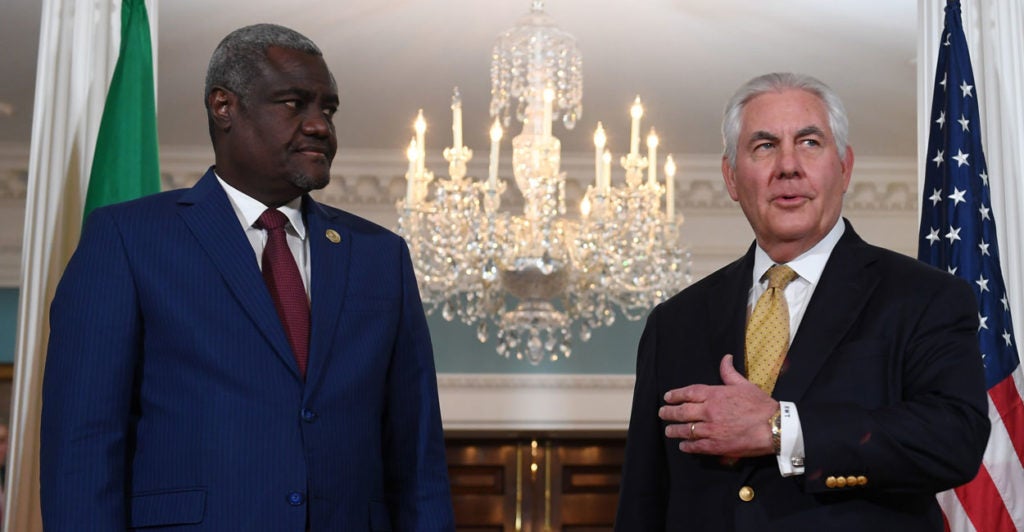President Donald Trump has ordered the Department of State and the U.S. Agency for International Development to come up with a plan to reorganize themselves to improve their efficiency, effectiveness, and accountability.
After decades in which trillions of taxpayer dollars have been sent overseas in the form of foreign assistance, it is not an unreasonable request by the president. Improvement of foreign aid is in the interest of all Americans.
To assist the Trump administration and Congress with reorganization plans, The Heritage Foundation published a comprehensive study that recommends a fundamental re-ordering of how the U.S. government delivers foreign assistance. Specifically, Heritage calls for:
- Complete restructuring of the U.S. Agency for International Development, or USAID, with its core health and humanitarian missions incorporated into the State Department.
- Transferring USAID’s development assistance work to the Millennium Challenge Corporation, a relatively new U.S. foreign aid agency with a superior business model.
- Tasking the Millennium Challenge Corporation with ensuring that all developing countries “graduate” from the need for foreign aid by adopting policies to strengthen the rule of law, attract private investment, and increase economic growth.
Other Washington think tanks are defending the status quo, arguing that USAID should remain as an independent agency, and perhaps even be expanded.
The Atlantic Council’s report on State Department reform repeats the words “independence” or “independent” in conjunction with USAID six times. The Center for Strategic and International Studies also calls for USAID to remain independent. The Center for Global Development calls for more effective foreign aid, but is silent on the future status of USAID.
The report from the Brookings Institution is the most forward-leaning, not just insisting on independence but actually calling for the USAID administrator to be raised to Cabinet rank—equal to Secretary of State Rex Tillerson, instead of his subordinate.
Here’s a question: Why did these centrist and left-leaning think tanks suddenly become concerned about USAID’s independence?
The answer likely is that they want to protect foreign aid programs started at USAID and elsewhere under President Barack Obama from cuts by the Trump administration. It’s sort of the development-assistance policy version of the “Resist” campaign.
And these think tanks never really precisely define what they mean by “independent.” Should the provision of foreign aid be insulated from broader U.S. foreign policy and security concerns? Should State and USAID be placed in an adversarial relationship, fighting over limited resources from Congress?
Both would be counterproductive outcomes. Foreign assistance programs were designed and are funded by Congress to help the State Department achieve the U.S. government’s foreign policy objectives. But an “independent” U.S. Agency for International Development is a stovepiped USAID.
This would continue a long-term trend: State steadily has ceded its role as lead foreign affairs agency to a host of other agencies in the decades since its core bureaucratic architecture was established after World War II.
For example, the Treasury Department long has had the lead on international fiscal and monetary policy. Trade policy is set by the Office of the U.S. Trade Representative in the White House. Other agencies have the lead on international airspace or telecommunications agreements, and on any number of other arcane scientific or global health issues.
This is not necessarily bad. It is no longer 1947, and the State Department does not and should not have the expertise to take the lead on the countless complicated issues that confront the government.
But foreign assistance is increasingly a core State Department function. Money is critical in influencing people and governments around the world to achieve America’s short- and medium-term national security objectives.
Those who trumpet USAID’s independence and oppose its merger with the State Department basically are arguing that the United States should have two State Departments—one with money and one largely without. That may fulfill the desires of bureaucrats building their fiefdoms or foreign aid contractors that prefer to deal with one independent federal agency, but such a solution ill serves the country.
Just as is the case overseas, where the U.S. ambassador is the senior-most official in an American embassy, in Washington the secretary of state should have undisputed authority over decisions about allocating U.S. foreign assistance.
The State Department—highly competent, well-equipped, appropriately staffed and resourced—should include a foreign assistance component. That is what countries such as Canada, Denmark, and Sweden already have done.
The Trump administration has signaled that it is ready to press for fundamental reforms.
Ambassador Mark A. Green, recently confirmed as administrator of the U.S. Agency for International Development, pledged during his Senate confirmation hearing to make “hard decisions” to reform and reshape USAID in particular and American foreign aid in general.
As Green has said, “aid should aim to build institutions that are effective, accountable, and ultimately replace aid.” In other words, a successful development strategy is one that renders development assistance unnecessary.
The defenders of the status quo complain that threatening a deep budget cut to USAID is not the right way to start a conversation about reform. In fact, after decades of studies recommending fixes to foreign aid, the Trump administration may have hit upon the only way to do it.
